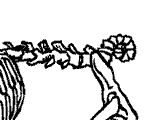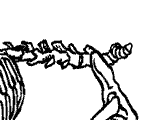|
Kurilian Bobtail



 |
|
History.This
is a natural breed, which existed in isolation for a
long period (at least 100-150 years) on a chain of
islands collectively known as the Kurils, which belong
to Russia and Japan. In Russia there are several
documents referring to cats with a short tail, which
were brought home from the islands by the members of the
military or scientists in the middle of the 20th
century. The character of these cats made them very
popular even without being promoted as a pedigreed cat.
Many people brought these cats home from the islands,
but historically in Russia there were no cat clubs and
therefore no breed standards to guide those who raised
them.
In
its natural,
wild habitat, this cat is
known to be both an excellent swimmer and fisherman and
an exceptional rat hunter. It is said to be no problem
for this cat to catch a 5 kg fish or a hare in the wild.
People who live in Kunashir report that bear will run
away from this cat! However, this breed is not well
known out of its native territories and the western
regions of Russia. It is still discovered in the wild on
a chain of islands known as the Kurils, which run from
the easternmost point of Russia to the tip of Japan's
Hokkaido Island. The population is small and it is
considered a very rare breed of cat. Part of the reason
for its rarity is that there are just 2 or 3 kittens in
a litter and it breeds only once per year in the wild. At
the first cat fancy exhibitions of the Kurilian Bobtail
(1990) many foreign experts were concerned that these
Russian cats with a short
tail were just a Japanese Bobtail of a heavier type.
Even today, it cannot be said that the Kurilian Bobtail
and the Japanese Bobtail have an entirely different
genetics. In fact, it is probable that the Kurilian
bobtail was the original source of mutation for the
short tail in the Japanese. Yet, the difference is that
the Japanese Bobtail is a created breed with a similar
tail. Russia has not enough Japanese Bobtail for the
realization of research into a comparison of the genetic
makeup of these breeds. However, the Kurilian are cats
of the wild type with a wild origin. Russian Breeders
have kept this distinction in the Kurilian, while the
Americans have created the elegant Japanese Bobtail.In
contrast, the genetics of the Manx is entirely different
from the genetics of the Kurilian. The bobtailed gene
has absolutely no harmful consequences such as the Manx
gene does and it has allowed these cats to exist in
their natural environment and interbreed without
intervention from man for centuries.
Character:
Kurilian Bobtail are strong cats, with a wild
appearance, large. They have excellent health and a very
well-balanced character. They love to be caressed and
are very gentle. In the wild this cat runs in packs,
similar to the wolves. It is also highly intelligent.
It has a great love for both human company and other
species of pets, and it is perfectly happy living in an
apartment in the city.
|
Main forms of the tail |
|
Whisk -form
of tail consists of 5-15 vertebrae. The length usually runs up to 5-13
cm or 2/3 of normal tail length. The vertebrae curve at obtuse angle.
They may keep partial flexibility in some junctions of the tail. The
vertebrae may form one or two strongly pronounced kinks. Such type of
“whisk” will look like zigzag. The tail of semi-longhairs is usually
bushy and proportionates to the body. But the same tail of shorthairs
may look somewhat absurdly. The
standard currently in force allows this form of tails. But a judge must
record that the length exceeds 5 cm and the tail does not harmonize with
the body
 |
|
Snag-
This form of tail mostly consists of 2-8 vertebrae,
strongly deformed as if they stick between them. The vertebrae joint
rigidly. The kinks are felt like knobs. The short-cut “snag” usually
consists of 2-3 still and rigid vertebrae. The presence of a skin pouch
on such a tail may testify that the laying of vertebrae was meant for
bigger length. But for some reason, the vertebrae resorbed or simply
deformed in the process of embryogeny. The vertebrae of such a tail may
coil up, but it is impossible to determine the direction of cockling due
to very close fitting. Sometimes, such a “snag” ends with 1-2 vertebrae,
thin enough and pointed aside. As is often the case, the vertebrae of
so-called “snag with outgrowth” keep partial flexibility.
It is difficult to count the exact
number of vertebrae as, very often, only the outgrowth can be felt. So
the expert may indicate by mistake on the result sheet that the tail
consists of 1 vertebra only. The situation can be clarified when finding
the tail base or having roentgenogram. In all cases, the expert must be
very experienced.
  |
|
Spiral.
This type of tail is the most beautiful and preferable.
This tail consists of 5-10 vertebrae deformed in the manner that they
form sharp angles in their junctions. These sharp angles permit the tail
to coil up. The “spiral” may look like a halfbagel or fishhook.
The vertebrae junctions can be
articulated or semi-rigid. It can also represent the combination of
articulated and rigid sections. In this case the cat is able to wag with
one or several sections of its tail. Such tails may be long enough if
the vertebrae are not so deformed. At the same time, semi-longhairs
camouflage the tail length with hair. The shorthairs having spiral tail
look very amusingly, if the tail size is in good proportion to the body.
The knitting of the spiral or
fishhook-shaped tail base with or their close laying along sacrum is
also possible. Then, it is difficult to measure real length of the tail.
It is true especially for short spiral tail.
   |
|
Delayed bobtail-
This form of tail commences as normal one. In other words
it is straight and free from defects for the space of 5-7 vertebrae, but
it ends with a hook consisting of some other deformed vertebrae of
different degree of articulation. At bottom of fact, the hook represents
a spiral or a zigzag. The alternation of curved and straight sections
makes odd combinations. It is especially typical for the first
descendants of female cats with normal tail
 |
|
|
STANDART
Fifè
/category
3/
 |
|
|
General |
large or medium sized,
well-muscled compact powerful body with short, pompom shaped
tail |
|
Head |
Shape -large, in shape of a
trapezium, rounded in contours, wide at the cheekbone level ,slightly
rounded in profile |
|
Chin -well-developed wide chin |
|
Nose - a gentle dip from the
forehead to the broad, medium long straight nose, without a
definite stop |
|
Ears |
Medium sized, wide at the base,
slightly pricked forward and rounded at the tips. Open at base
with lynx-like tufts and long hair out of the ears. |
|
Placement - set wide apart and
medium high distance between the ears is equal to the width of
one ear |
|
Eyes |
Shape - rounded set wide apart and
slightly slanted |
|
Colour - any colour from yellow to
green, white cats and colour varieties with white may have blue
or odd eyes |
|
Body |
Compact, muscled, solid bone
structure, back shows delicate curve from the shoulders to the
rump which is higher |
|
Legs |
Medium in length, strong, sturdy
hind legs longer than forelegs. Paws rounded |
|
Tail
|
composed of one or more angles or
curves or any combination there of may be rigid or flexible, the
direction of curves is not important. Visible length of the tail
(without coat) from 3 to 8 cm. Size and shape of the tail should
harmonize with the overall appearance of the cat |
|
Coat |
Structure - dense, rather fine in
texture, medium long, with slight guard hair, well-developed awn
hair and slight undercoat
a fully coated cat is desirable and has a shirtfront, a full
frill, and breeches |
Colour - all with the exception of
colourpoints, chocolate, cinnamon, fawn, lilac and the same
combined with white
any amount of white is allowed, i.e. a white blaze, white locket,
white chest, white on the belly, white on the paws, etc.
refer to following tables |
|
Faults
|
Slender type ,Japanese Bobtail
type ,extreme arch-like back not in harmony with the appearance
of the cat |
|
Tail length from 8 to 12 cm or
less than 3 cm. Tail with only one vertebra .Delayed bobtail
effect |
|
Disqualification
|
Deformities of the spinal
vertebrae |
|
Absence of the tail bone , short
straight tail without angles and curves ,tail longer than 12cm. |
|











